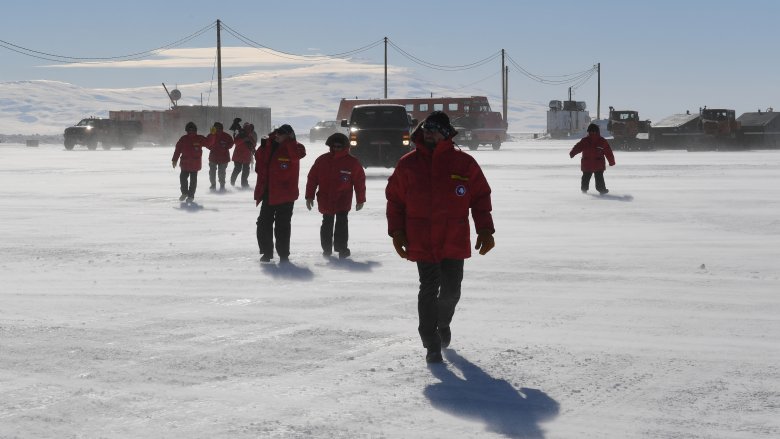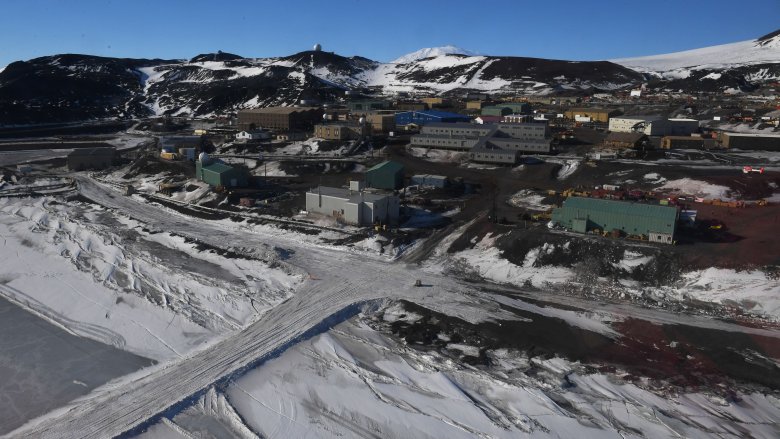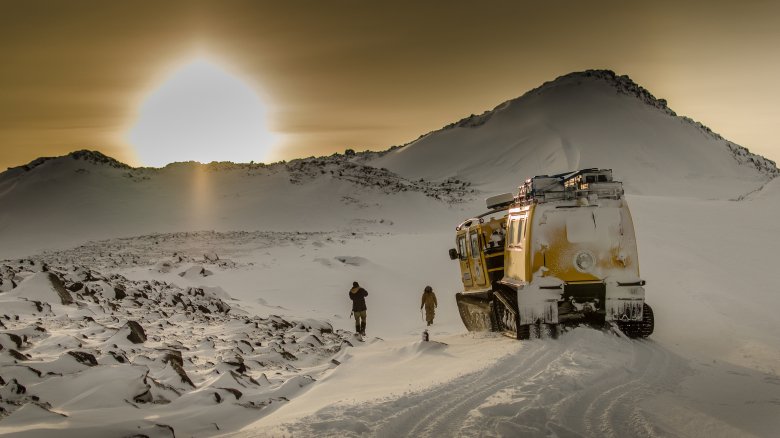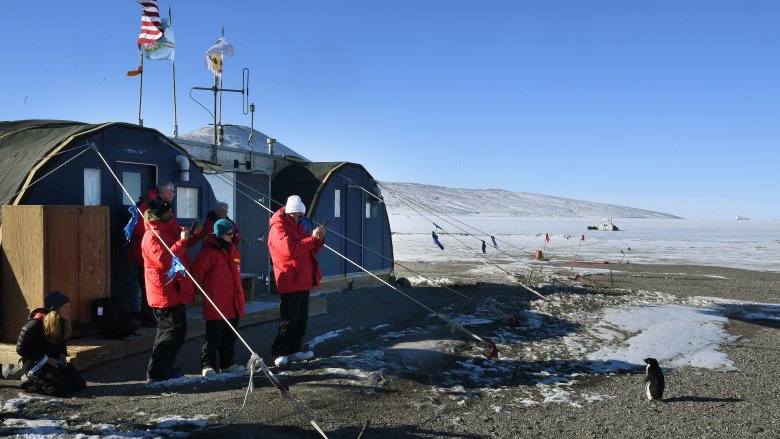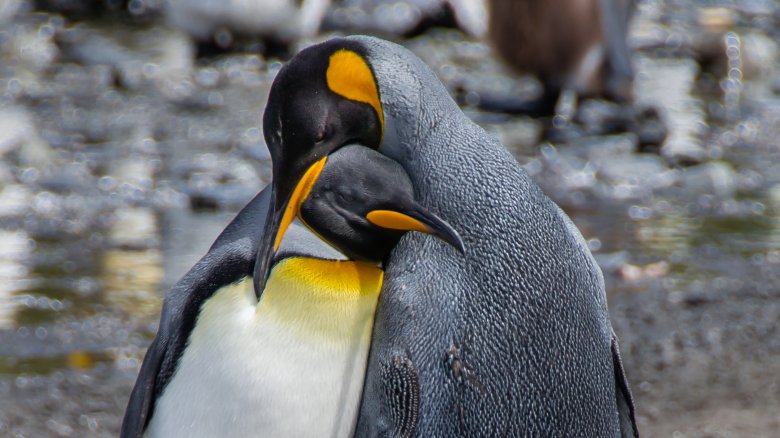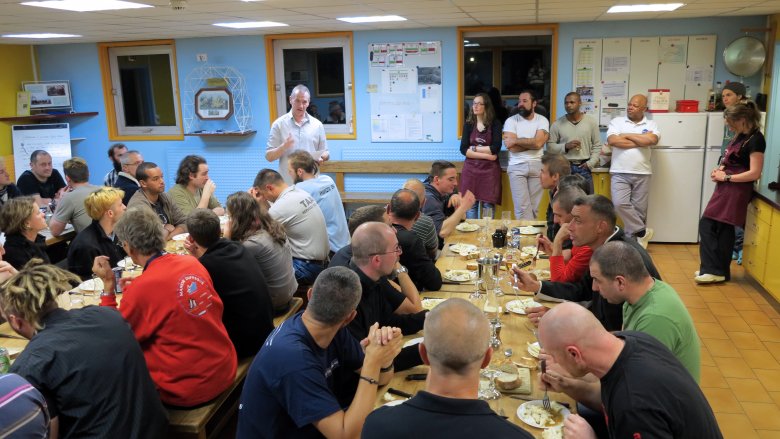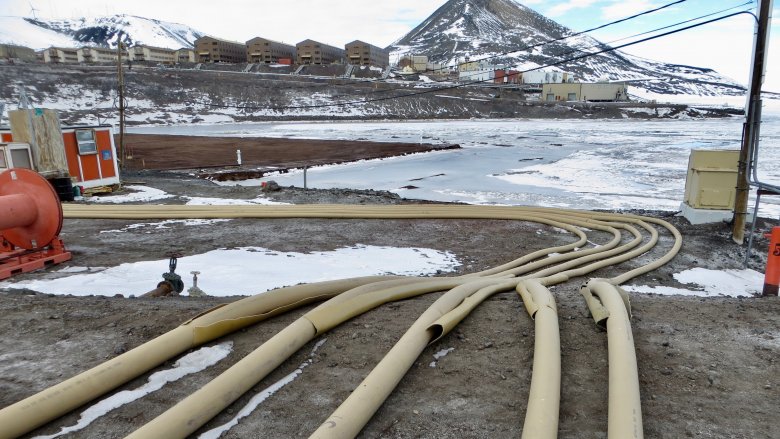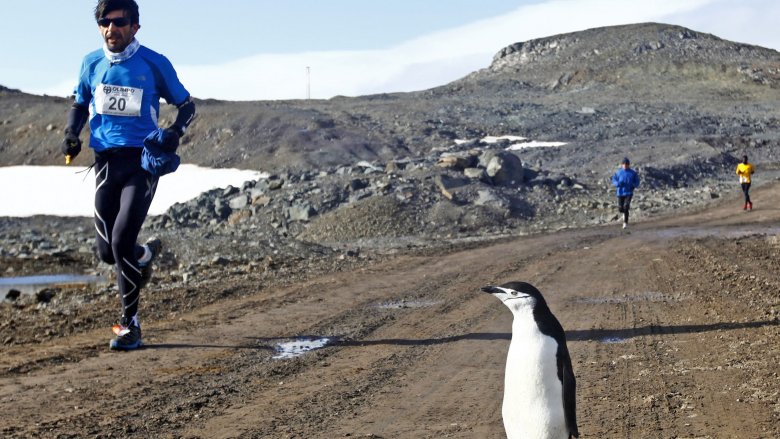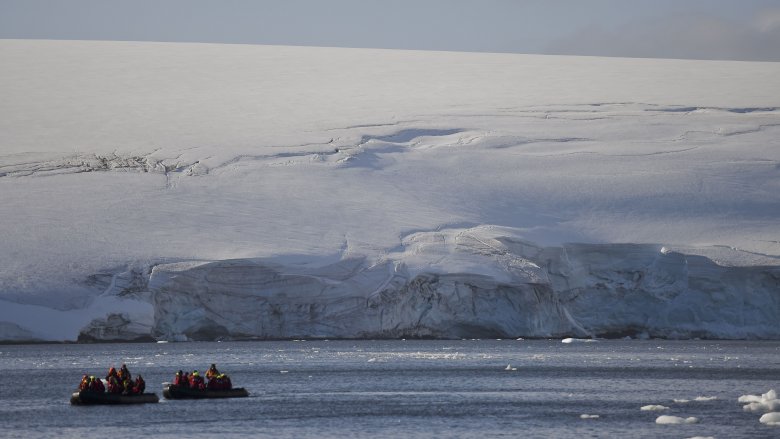Secrets Of Living In Antarctica
For thousands of years, people theorized about the existence of a giant continent smack-dab on the bottom of the Earth, but it wasn't until the last few centuries that Antarctica was truly discovered. Now, while the Arctic Circle is also a pretty chill place, it's still accessible enough that many people throughout history have made a life there. Not so in Antarctica, a frozen landmass with no native human population, where the only creatures that could ever truly feel at home are penguins, orcas, Elder Things, or that shape-shifting alien monster that John Carpenter called "the Thing."
Despite being the coldest and most brutal environment on the planet, a surprisingly large number of human beings have managed to "live" in Antarctica. The increasing dangers of climate change have made studies in Antarctica increasingly important, so the majority of these "Antarcticans" are scientists, but not all of them. Though Antarctica has no native government, it does have schools, athletic competitions, and an annual rock concert.
Antarctica has a peak population of about 4,000
Four thousand people doesn't sound like much, until you remember that all these crazy folks are living in Antarctica, a proposition which sounds like a "Truth or Dare" game gone horribly wrong. But that 4,000 isn't a steady number. According to the Independent, that's just the population during the "summer" months between November and March, when climates aren't quite so bloodthirsty. When winter comes around, most people hightail it back to human-level climates. Regardless, Antarctica has no natives, so everyone who lives there is an alien, and the vast majority of residents are scientists in the fields of geoscience, life science, and physical science, according to the Scientific Committee on Antarctic Research.
The most populated settlement is McMurdo Station, owned and operated by the United States. The Independent describes McMurdo as a "frozen frontier town," and it has a summer population of about 1,200 workers. Crazy as it sounds, McMurdo is like the New York City of Antarctica. In addition to housing, the "town" also has perks like an ATM, a chapel, road signs, a hospital, the McMurdo General Store, and — most importantly — three bars, according to Wired.
However, McMurdo is far from the only Antarctic station. Because Antarctica has no native government, many different countries all own a piece of the (frozen) pie. According to the informational website Cool Antarctica, the frozen continent is speckled with dozens of sparsely populated bases, run by countries such as Finland, Chile, Japan, Pakistan, and Germany.
Some people live there in the winter, too
If Ned Stark lived in Antarctica, February would be the time he'd start grimly staring into his beer and grumbling about the changing seasons. By then, most of the workers sail away to warmer waters, but a few grizzled badasses stay behind for the whole cold, dark duration, during which temperatures drop to -100 degrees Fahrenheit, according to The Atlantic. The severe cold is just one aspect of Antarctic winters, though. While summers are lit by a midnight sun, winters are a time of total darkness for months on end — ample time for vampires to emerge.
Living without sunlight for months at a time can cause serious mood disorders, so people who sign up to work in Antarctica first undergo psychological screening to make sure they aren't at risk. The lack of vitamin D means depression is a real possibility, especially when you combine those months of darkness with near-total isolation from the outside world. It's like being on Planet X.
How do people cope? The same way they do here in the regular world: by taking yoga classes, learning foreign languages, working out at the gym, reading at the library, and tending hydroponic greenhouses. In an interview with Cosmopolitan, Antarctic worker Keri Nelson describes the period of darkness as being "meditative and peaceful and centering." She also mentions that the best parts of any Antarctic winter are the many costume parties, where people run out beneath the starry sky in unicorn costumes.
Yes, there are Antarctic families
Someday in the future, if someone tells you they grew up in Antarctica, they might be telling the truth. Strange as it seems, there are and have been families in Antarctica, who've huddled together a few little South American towns such as Chile's Villa Las Estrellas, and the Argentinian outpost of Esperanza.
According to the New York Times, Villa Las Estrellas is like any other small Chilean town, other than those pesky subzero temperatures. The village, formed in 1984, has a population of less than 200. Features include a cemetery, a hospital, a bank, a canteen, and an indoor gym where people can play soccer. Barbecues have been hosted, where residents share drinks of pisco, a Chilean brandy. Most significantly of all, though, is that Villa Las Estrellas is home to multiple families, plus a schoolhouse where two teachers give lessons to about a dozen students. It seems surprisingly similar to growing up in many tiny villages.
Meanwhile, Argentina runs Esperanza, over on the northern end. Esperanza has many of the same features, including a cemetery, a school, and a scout troop. What makes Argentina's southernmost town unique is that it was home to the first human ever born in Antarctica: Emilio Marcos Palma, born in 1978. According to Mental Floss, Palma's birth happened in Antarctica because the Argentinian government flew in his mother, Silvia Morella de Palma, specifically to lay claim to the first natural-born "Antarctican" citizen in history.
There are entry-level jobs in Antarctica
Maybe you've been quietly dreaming of living in Antarctica since the first time you saw a penguin on Animal Planet. However, if college steered you down another career track, or science was never your thing, you might've cast those dreams aside a long time ago. Fear not: you don't have to be a scientist to live and work in Antarctica. There are entry-level positions available!
Just ask Keri Nelson, who discussed her Antarctic life in an interview with Cosmopolitan. Nelson was in her twenties when she moved to McMurdo in 2007. She got her start working as a janitor, and she worked her way up the ranks to a position in the general store. She also says that if you use this experience to get into advocacy work, you can funnel an Antarctic job into a political career in Washington D.C. So yeah, there's a lot of upward mobility.
While Nelson stipulates that entry-level jobs tend to involve washing toilets or doing everybody's dishes, there are a variety of jobs available. For example, a mailperson needs to deliver everyone's letters and packages. People have to do the financial books. In the general store, someone needs to stock the shelves. There are lots of options open to people to people who want to experience the most out-there place on Earth, but keep in mind, you're going to be working some long, hard hours for at least a couple months.
Inter-Antarctican relationships are common
One day, some studio executive is going to make a Grey's Anatomy about all the relationships going on at the bottom of the world. Keri Nelson says relationships between Antarcticans are a common occurrence, in her Cosmopolitan interview. For example, Nelson actually met her husband there, when she was stationed at McMurdo and he was stationed 3 kilometers away at New Zealand's Scott Station. According to Nelson, the two destined lovers used to both walk out of their bases into the Antarctic night, meeting halfway to gaze out at the stars and Moon. Good luck getting more romantic than that. Now, while they met and romanced each other in the iciest continent, they didn't marry there: their wedding was held in the tropical getaway of Michigan. Still, doesn't the whole story sound ripe for a great rom-com adaptation?
Anyway, this happily married couple isn't the only example of South Pole romance. According to New York Magazine, at least one Antarctic romance got started thanks to the infamous dating app Tinder. Evidently, both of these lonely and hopeful scientists happened to be using Tinder at the same time in 2014, less than an hour's helicopter ride away from each other — and happily, both of them swiped right. The two met in person a few weeks later. Because their identities are anonymous, it's not yet known if wedding bells are on the horizon, but we'll keep our fingers crossed for a happy ending.
It's like being in college again, especially with all the drinking
It's hard to imagine anyone would ever think of the South Pole as being party central — and it isn't. However, it does seem like living on Earth's lowest continent is somewhat reminiscent of college life. Keri Nelson describes her experience as a "college campus atmosphere," due to everyone sleeping in dorms, sharing bunk beds, and eating in the cafeteria. At McMurdo, friends hang out at the bar, get together for band practice, go hiking, or gather around for Game of Thrones.
There's a dark side to the long winters, though, according to The Atlantic. Some people get hit especially hard by isolation, depression, and addiction. Spending nine months of winter in the coldest, darkest place on the planet certainly isn't good for those who already struggle with alcoholism. Some people have specifically gotten jobs in Antarctica to get away from their other problems, only to find themselves plunging deeper and deeper into the bottle.
The alcohol supply has to last all nine months, but it doesn't always make it. At Club 90 South, there was one year the beer and wine supply ran out early due to particularly heavy drinking. Some people have been observed to drink just to make the days go by faster, resulting in situations where it's seen as less dangerous to let a person pass out in the bar than it is to allow them to walk out into the cold inebriated.
There's an annual concert at the bottom of the world
Anyone who has been following the cold splash of great music coming out of Iceland in the last few decades knows that chilly climates can bring about some amazing music. However, when picturing the "music scene" in Antarctica, one would imagine a sealed room with a couple guitars, or maybe some penguins drumming on icebergs. What almost no one on the northern 90 percent of the planet realizes is that every New Year's Day, a bunch of people in Antarctica get together and jam out for an annual outdoor concert.
According to Wired, every New Year in Antarctica begins with IceStock, a six-hour outdoor concert that has been an annual cultural centerpiece since 1990. It's definitely a DIY affair, with a stage made of two flatbeds, and parachutes sometimes flying in the background to create a cool visual. IceStock features solo acoustic performances, didgeridoo players, and rousing rock bands such as Penguins in Bondage. All of the bands are "local" acts, formed by Antarctic workers who practice together in their spare time.
IceStock might be the biggest music event that happens on the frozen landmass, but as described by Wired, it's hardly the only one. At McMurdo Base, the bars often feature live music, there are acoustic nights every two weeks, and there's a special evening of women's music, as well.
You can't use the internet that much
Don't get too excited by stories of miraculous Tinder matches in the world's iciest environment because when you're in Antarctica, you're lucky if you can have a successful Facebook conversation. While there is internet service, it's not great. In an interview with ExtremeTech, South Pole communications technician Marty Keefe described Antarctic internet access as being "extremely limited." He explains that this isn't so much a problem of internet connectivity as it is the fact that internet access is primarily intended for science support, scientific channels, and important blah blah blah. Service is slow, ping times are high, and services like Steam are blocked. Even Skype use is strictly limited. So if you go down there, don't count on your Netflix subscription to occupy the boring times. If you want to watch The Walking Dead, you better bring it with you.
In Cosmopolitan, Keri Nelson relayed similar points, saying it was hard to use a smartphone down there. She pointed out that you need to schedule your internet times carefully, so you can slot in some rapid catchup time on your social networks, Gmail inbox, and so on. So yeah, while you might be able to capture a great Instagram photo down at the South Pole, it might take a long time to start raking in the likes.
There are athletic competitions
If your ambitions are athletic in nature, Antarctica probably isn't the top spot in your mind. However, if you're down with the cold, there are plenty of ways to keep in shape.
For one, there's an annual rugby match called the Ross Island Cup, according to Discover, where teams of scientists throw down, passing the ball and tackling each other at the foot of an active volcano. Evidently, New Zealand usually wins. If you're more of a runner, check out the McMurdo Marathon, an annual event where participants run 26 miles across the frigid landscape, as told by the New York Times. Runners can also participate in the Race Around the World, according to the Antarctic Sun, where participants go all the way around the geographic South Pole, thus crossing through every longitude line on the planet.
The most extreme sports achievement of all might belong to those who've participated in the so-called "300 Club," a streaking competition described by The Atlantic. To join the vaunted ranks of the 300 Club, one must successfully handle a 300-degree (Fahrenheit) temperature switch, totally naked. "Participants" start in a 200-degree sauna, and then, wearing nothing but shoes, run out into -100 degree weather outside, race around the Ceremonial South Pole, and then make it back to safety. Yes, it's as dangerous as it sounds. The tradition's origins date back to 1959, so Antarcticans have been getting naked for a long time.
Tourist numbers are increasing
Tourism to Antarctica has been increasing in leaps and bounds over the last few decades. According to USA Today, tourists back in the 1980s were scared of getting their feet cold, and back then the continent saw fewer than 2,000 visitors a year. However, this number skyrocketed to 46,000 visitors a year in the 2007-08 seasons, and according to CNN, the 2015-16 season saw about 38,500 tourists coming in.
Is that good news? Not necessarily, according to environmental scientists interviewed by CNN. The problem is that due to climate change, Antarctica is the most rapidly warming part of the globe, and if the number of giant ships coming in and burning huge amounts of fossil fuels increases too much, that won't be a good thing for either the wildlife or the planet as a whole. People who come to Antarctica want to observe the pristine nature there, but humanity's carbon footprint is dangerous to the fragile ecosystem. This is what nature documentaries are for.
In addition, potential travelers should be aware that a vacation to Antarctica is a lot more dangerous than most trips would be. As described by USA Today, a 1979 aircraft once flew into whiteout conditions, smashed into a mountain, and killed all 257 passengers. People who have attempted to skydive in Antarctica have died from a lack of oxygen. Everyone must make their own decisions, though. Potential Antarctic explorers: know the risks, then live your life.
